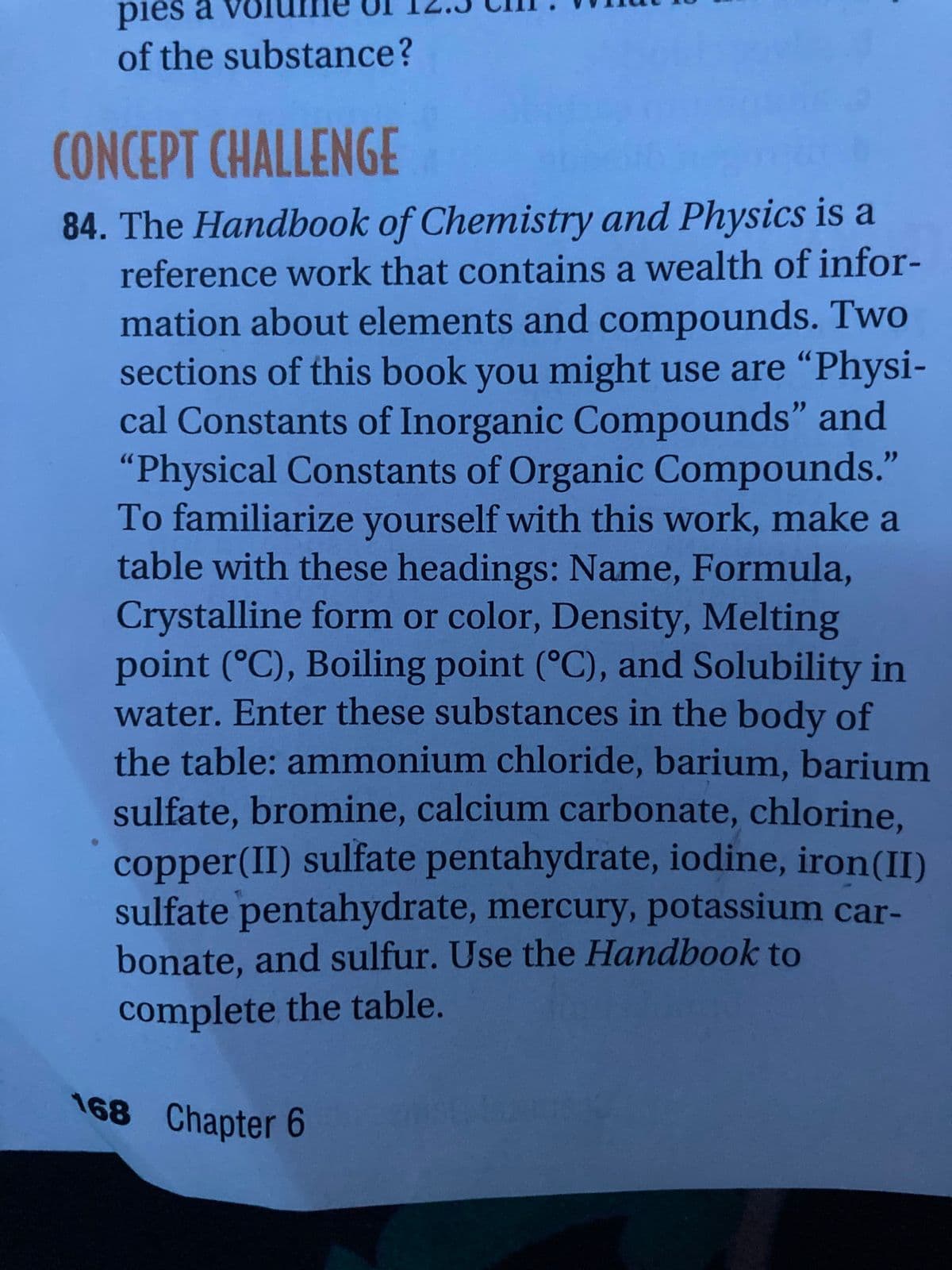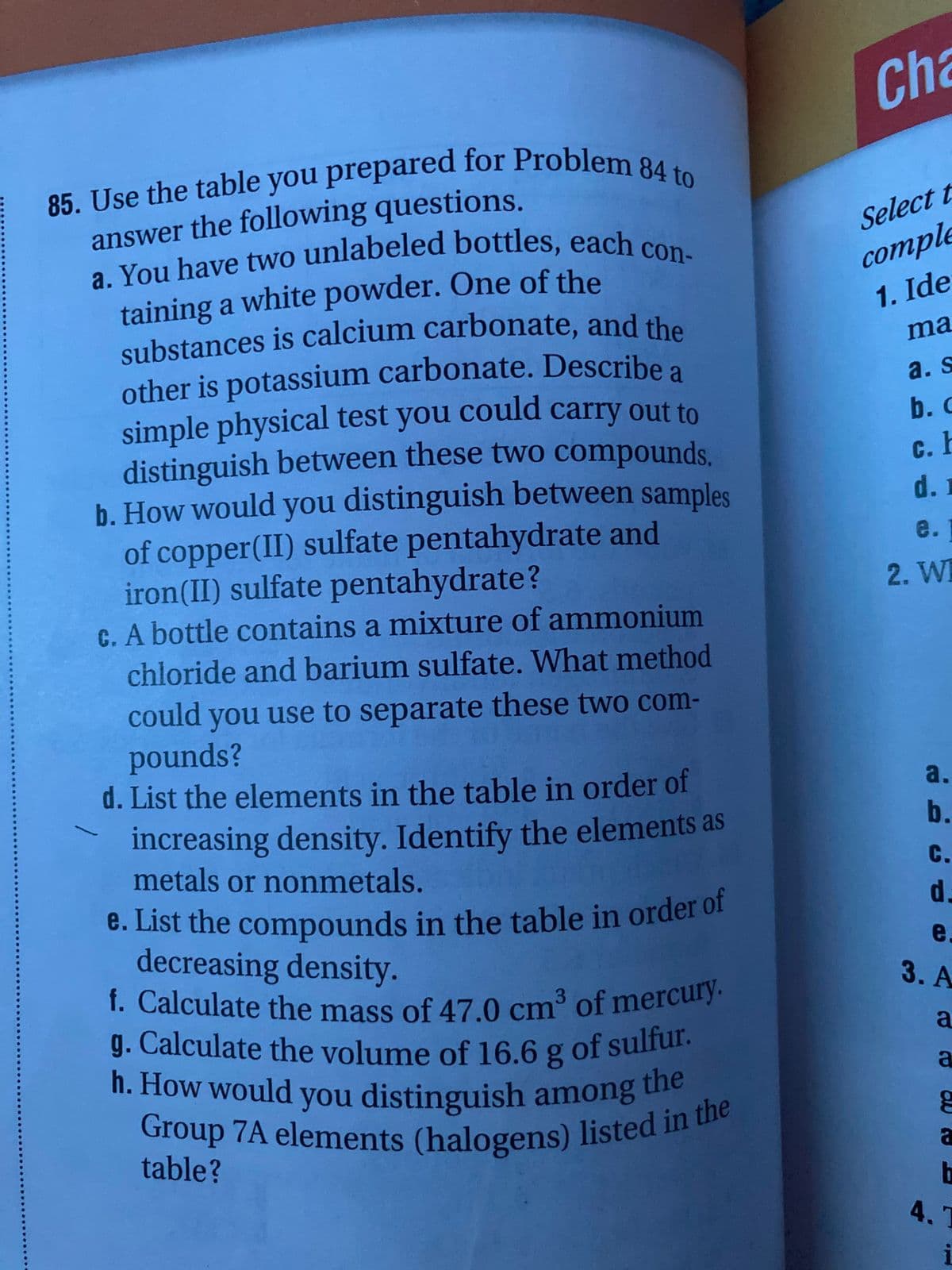84. The Handbook of Chemistry and Physics is a reference work that contains a wealth of infor- mation about elements and compounds. Two sections of this book you might use are "Physi- cal Constants of Inorganic Compounds" and "Physical Constants of Organic Compounds." To familiarize yourself with this work, make a table with these headings: Name, Formula, Crystalline form or color, Density, Melting point (°C), Boiling point (°C), and Solubility in water. Enter these substances in the body of the table: ammonium chloride, barium, barium sulfate, bromine, calcium carbonate, chlorine, copper(II) sulfate pentahydrate, iodine, iron(II) sulfate pentahydrate, mercury, potassium car- bonate, and sulfur. Use the Handbook to complete the table.
84. The Handbook of Chemistry and Physics is a reference work that contains a wealth of infor- mation about elements and compounds. Two sections of this book you might use are "Physi- cal Constants of Inorganic Compounds" and "Physical Constants of Organic Compounds." To familiarize yourself with this work, make a table with these headings: Name, Formula, Crystalline form or color, Density, Melting point (°C), Boiling point (°C), and Solubility in water. Enter these substances in the body of the table: ammonium chloride, barium, barium sulfate, bromine, calcium carbonate, chlorine, copper(II) sulfate pentahydrate, iodine, iron(II) sulfate pentahydrate, mercury, potassium car- bonate, and sulfur. Use the Handbook to complete the table.
Chemistry: The Molecular Science
5th Edition
ISBN:9781285199047
Author:John W. Moore, Conrad L. Stanitski
Publisher:John W. Moore, Conrad L. Stanitski
Chapter2: Chemical Compounds
Section: Chapter Questions
Problem 48QRT
Related questions
Question
I need help with this since I do not have the resource it asks me to use.

Transcribed Image Text:pies
of the substance?
CONCEPT CHALLENGE
84. The Handbook of Chemistry and Physics is a
reference work that contains a wealth of infor-
mation about elements and compounds. Two
sections of this book you might use are "Physi-
cal Constants of Inorganic Compounds" and
"Physical Constants of Organic Compounds."
To familiarize yourself with this work, make a
table with these headings: Name, Formula,
Crystalline form or color, Density, Melting
point (°C), Boiling point (°C), and Solubility in
water. Enter these substances in the body of
the table: ammonium chloride, barium, barium
sulfate, bromine, calcium carbonate, chlorine.
copper(II) sulfate pentahydrate, iodine, iron(II)
sulfate pentahydrate, mercury, potassium car-
bonate, and sulfur. Use the Handbook to
complete the table.
168 Chapter 6

Transcribed Image Text:a. You have two unlabeled bottles, each con-
85. Use the table you prepared for Problem 84 to
e. List the compounds in the table in order of
h. How would you distinguish among t
f. Calculate the mass of 47.0 cm³ of mercury.
g. Calculate the volume of 16.6 g of sulfur.
Group 7A elements (halogens) listed in the
other is potassium carbonate. Describe a
substances is calcium carbonate, and the
Cha
answer the following questions.
Select t
taining a white powder. One of the
substances is calcium carbonate, and the
other is potassium carbonate. Describe a
simple physical test you could carry out to
distinguish between these two compounds.
b. How would you distinguish between samples
of copper(II) sulfate pentahydrate and
iron(II) sulfate pentahydrate?
C. A bottle contains a mixture of ammonium
chloride and barium sulfate. What method
comple
1. Ide
ma
a. s
b. c
с.
d. 1
e.
2. W
could you use to separate these two com-
pounds?
d. List the elements in the table in order of
a.
increasing density. Identify the elements as
metals or nonmetals.
b.
с.
e. List the compounds in the table in order of
decreasing density.
T. Calculate the mass of 47.0 cm³ of mercury.
d.
e.
3. A
h. How would you distinguish among
the
a
table?
a
4.T
Expert Solution
This question has been solved!
Explore an expertly crafted, step-by-step solution for a thorough understanding of key concepts.
This is a popular solution!
Trending now
This is a popular solution!
Step by step
Solved in 2 steps with 1 images

Knowledge Booster
Learn more about
Need a deep-dive on the concept behind this application? Look no further. Learn more about this topic, chemistry and related others by exploring similar questions and additional content below.Recommended textbooks for you

Chemistry: The Molecular Science
Chemistry
ISBN:
9781285199047
Author:
John W. Moore, Conrad L. Stanitski
Publisher:
Cengage Learning

Chemistry: Principles and Practice
Chemistry
ISBN:
9780534420123
Author:
Daniel L. Reger, Scott R. Goode, David W. Ball, Edward Mercer
Publisher:
Cengage Learning

Chemical Principles in the Laboratory
Chemistry
ISBN:
9781305264434
Author:
Emil Slowinski, Wayne C. Wolsey, Robert Rossi
Publisher:
Brooks Cole

Chemistry: The Molecular Science
Chemistry
ISBN:
9781285199047
Author:
John W. Moore, Conrad L. Stanitski
Publisher:
Cengage Learning

Chemistry: Principles and Practice
Chemistry
ISBN:
9780534420123
Author:
Daniel L. Reger, Scott R. Goode, David W. Ball, Edward Mercer
Publisher:
Cengage Learning

Chemical Principles in the Laboratory
Chemistry
ISBN:
9781305264434
Author:
Emil Slowinski, Wayne C. Wolsey, Robert Rossi
Publisher:
Brooks Cole

Chemistry: An Atoms First Approach
Chemistry
ISBN:
9781305079243
Author:
Steven S. Zumdahl, Susan A. Zumdahl
Publisher:
Cengage Learning

World of Chemistry, 3rd edition
Chemistry
ISBN:
9781133109655
Author:
Steven S. Zumdahl, Susan L. Zumdahl, Donald J. DeCoste
Publisher:
Brooks / Cole / Cengage Learning

Chemistry: Principles and Reactions
Chemistry
ISBN:
9781305079373
Author:
William L. Masterton, Cecile N. Hurley
Publisher:
Cengage Learning